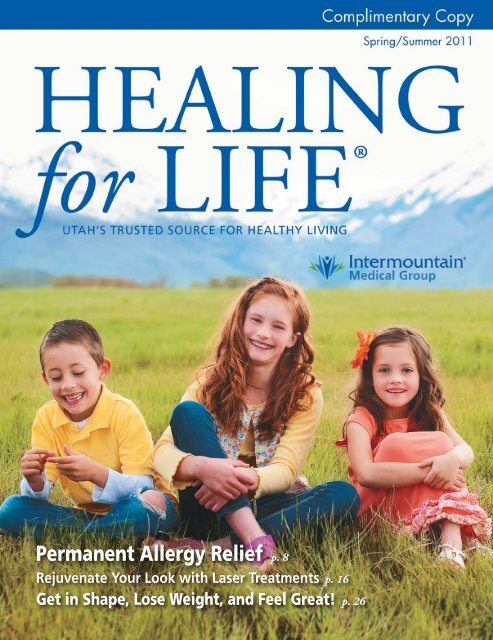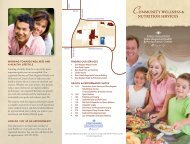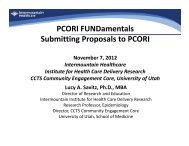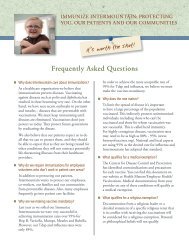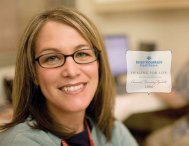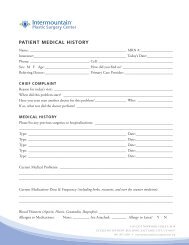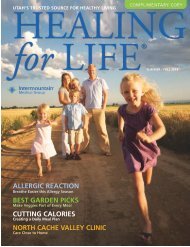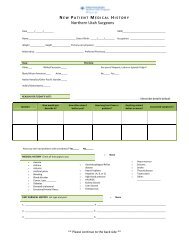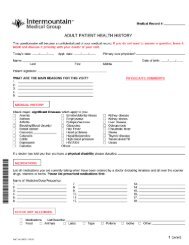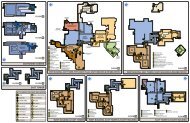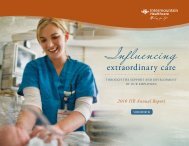permanent allergy relief? - Intermountain Healthcare
permanent allergy relief? - Intermountain Healthcare
permanent allergy relief? - Intermountain Healthcare
- No tags were found...
You also want an ePaper? Increase the reach of your titles
YUMPU automatically turns print PDFs into web optimized ePapers that Google loves.
ROOMTHECLASSROOMNewTreatmentfor ThoracicAorticDiseaseBy John R. Doty, MDThe aorta is the major artery carryingblood directly out of your heart. Itcurves up and around, and, alongthe way, its branches supply bloodto your brain, arms, and spinalcord. Once the aorta crosses intoyour abdomen, additional branchessupply your abdominal organs andkidneys before dividing into the major leg arteries. A healthyaorta contributes to your quality of life.A healthy aorta is both flexible and resilient, able to withstandthe changes in blood pressure that occur with each heartbeat.Any condition that results in a weakened aorta is termed“aortic disease.” Conditions such as high blood pressure,atherosclerosis, and smoking can produce deposits calledplaques and calcifications in the wall of the aorta. Thesecan cause the aortic wall to become stiff and less resilient,weakening its ability to handle the stress of circulating blood.Some common aortic diseases include aortic aneurysm,penetrating aortic ulcer, aortic dissection, and aortictransection. All of these diseases can be life-threatening.The first of these diseases, aortic aneurysm, occurs when aportion of the aorta becomes enlarged. Aneurysms tend todevelop if you have high blood pressure, coronary arterydisease, aortic valve disease, or connective tissue disorders suchas Marfan syndrome. The first sign of an aortic aneurysm canbe acute rupture: the enlarged portion of the aorta bursts, andthe result is massive bleeding.Penetrating aortic ulcer is a condition in which a small area ofthe inner aortic wall erodes, allowing blood to push into andsometimes completely through the outer aortic wall. An aorticulcer can cause your aorta to split or rupture.Aortic dissection develops when the lining of the aorta splits,creating a false channel for blood flow within the aortic wall.Aortic dissection is usually associated with severe back pain.Once the aorta splits, either it can rupture or blood flow to amajor artery (such as the artery to the brain or kidneys) can bereduced. Aortic dissection is the disease that caused the suddendeath of actor John Ritter.Aortic transection, a separation of the ends of the aorta, oftenoccurs during a severe blunt impact (for example, a motorvehicle accident). Acute transection may result in death frombleeding. When either aortic dissection or transection isidentified, this is termed an “acute aortic syndrome” and oftenrequires emergency surgery.continued pg 14 ...Feel better about being sick.FAST, CONVENIENT, QUALITY HEALTHCARE.Taking care of everyday illnesses and accidents is as easy as one, two, three.One, <strong>Intermountain</strong> InstaCares are fast. Two, there’s most likely a location within afew minutes’ drive. And three, you know you’ll have a quality doctor taking care of you.Which means you can feel more confident in the care you receive when you’re sick.InstaCareBountiful Clinic: 390 North Main St • (801) 292-6100Holladay Clinic: 3934 South 2300 East • (801) 273-6777Memorial Clinic: 2000 S 900 E • (801) 464-7777Murray Clinic: 196 E Winchester St • (801) 639-5500Sandy Clinic: 9493 South 700 East • (801) 576-0176Southridge Clinic (Riverton): 3723 West 12600 South, #150 • (801) 285-4560Taylorsville Clinic: 3845 West 4700 South • (801) 840-2020Tooele Clinic: 777 N Main St.Tooele • (435) 228-1200West Jordan Clinic: 2655 West 9000 South • (801) 568-9933Instacareutah.org12 INTERMOUNTAIN MEDICAL GROUP <strong>Intermountain</strong>MedicalGroup.org
ROOMTHECLASSROOMREJUVENATE YOUR LOOKAT THE ALTA VIEW SPECIALTY CENTERFigure 1.3D CT scan of aortic aneurysm.Figure 2a.Ascending aortic aneurysm.Figure 2b.Synthetic graft replacement ofascending aortic aneurysm.Figure 3.X-ray of TEVAR procedure.Photography courtesy of John R. Doty, MD... continued from pg 12If you are diagnosed with aortic disease, you need to addressany conditions that might contribute to the disease. Thatmeans carefully managing your blood pressure, controllingcardiovascular risk factors, and quitting smoking.Monitored follow-up is an important part of the managementof aortic disease. Regular CT scans allow aneurysms and otheraortic diseases to be tracked so that surgery can be performedbefore dissection or rupture occurs (Figure 1). If you haveaortic disease, you may also have other forms of heart orarterial disease; additional testing such as ultrasounds candetect these conditions and guide treatment. Depending onthe extent of the disease, surgery may be the best solution.If an aortic aneurysm is growing or is larger than about 5.0centimeters, your physician will recommend a surgical repair.The kind of repair will be based on whether the aortic diseaseis in the ascending or descending aorta.If the aneurysm is located in the ascending aorta (Figure 2a), asynthetic graft (Figure 2b) will be used to replace the damagedportion of the aorta. If the aortic valve is diseased, it will alsobe replaced. Repair of the ascending aorta requires standardopen-heart surgery.When the aortic disease affects the descending aorta, thesurgical repair can often be performed without entering thechest. This is known as thoracic endovascular aneurysm repair,or TEVAR. In this procedure, a stent-graft, a flexible graftplaced inside the aorta, seals off the diseased portion. Thestent-graft is “deployed” above and below the diseased portionof the aorta (Figure 3). For many patients, because TEVARis safer and less invasive, recovery is more rapid than withtraditional “open” operations.The TEVAR procedure can also be used with aorticdissection and aortic transection. The stent-graft stabilizesthe torn portion of the aorta and reduces the chance forrupture.No matter what kind of aortic disease you have, thephysicians at <strong>Intermountain</strong> Medical Center are dedicatedto its coordinated evaluation, treatment, and long-termmanagement. Using the most advanced techniquesand facilities, cardiac surgeons, vascular surgeons, andinterventional radiologists collaborate to provide optimalcare. Once you recover and are discharged from the hospital,all scheduled follow-up can be conveniently performedthrough <strong>Intermountain</strong> <strong>Healthcare</strong> facilities.To make an appointment with a cardiothoracic surgeonnear you, we invite you to visit the index at the back of thispublication or intermountainmedicalgroup.org.John R. Doty, MDCardiovascular & Thoracic Surgery<strong>Intermountain</strong> Heart & LungSurgical Associates801.507.3600utahheartsurgery.orgWE UNDERSTAND THAT IT CAN BE BOTH EXCITING AND STRESSFUL to undergo a newcosmetic procedure, so our staff is trained to provide excellent comfort and support to our patients bothbefore and after their treatment.For those of you who are not familiar with our services, we would be happy to meet with you and decideon the best treatment plan. Please call Alta View Plastic Surgery Specialists to schedule a consult.Cosmetic Dermatology 801-501-6200Plastic and Oculoplastic Surgery 801-501-62509450 South 1300 East, Sandy, Utah 84094You may also visit altaviewplasticsurgery.org for more information.14 INTERMOUNTAIN MEDICAL GROUP <strong>Intermountain</strong>MedicalGroup.org
THECLASSROOMTHECLASSROOMTHECLASSROOMTHECLASSROOMLaserTreatmentsq&aBy Jason Hancey, MDtoday’s society is fascinated with new technology.Lasers are generally thought of as state-ofthe-artor cutting-edge technology. The useof lasers in medicine, however, is not a newphenomenon. Physicians have used lasers forsurgical incisions, tumor resection, eye surgery,and dentistry. Cosmetic surgery is by far themost common application of lasers in medicine.Recently, there has been renewed interest in laser treatmentsfor brown spots, wrinkles, and other signs of aging.Older laser treatments were often ablative, meaning theyremoved the entire upper layers of skin, resulting in sore,open wounds that often took weeks to heal and resultedin months of skin redness. Those who underwent thistreatment often had good results, but at too high a costduring the healing phase. New laser treatments result in afew days of skin redness, no wounds, and rapid return tonormal activities.Laser FacialRejuvenationWrinkle Treatment, Brown Spots,DiscolorationLaser treatments can dramaticallyimprove wrinkles and scars with verylittle down time. In studies, laser hasbeen shown to stimulate and remodelthe collagen in the dermis as well astighten the skin. This is very helpfulfor wrinkles as well as acne scars.Brown spots and discoloration canbe treated at the same time, in onesession. Most people experience slightredness and a mild burning sensationin the first day or two after eachtreatment. Patients often say it feelssimilar to the snap of a rubber band.The treatment causes only minimaldiscomfort, and any initial soreness iseasily alleviated with a cold air coolingsystem. We are happy to provide localanesthesia for your comfort; however,most patients require no anesthesia fortheir treatments.How does it work?Laser treatment works by directinga beam of light into the skin at aspecific target (chromophore), suchas a pigment spot or small bloodvessel. Through non-selective tissuecoagulation it stimulates collagenproduction to smooth and tightenthe surrounding tissue, resulting inimproved skin texture.Am I a candidate?Your doctor can help you determineyour specific needs. Your entire facecan be treated, you can select certainareas like crow’s feet or the upper lips.Are there any side effectsto treatment?Anti-aging treatment should causeonly minimal discomfort. Anyredness, swelling, or puffiness thatoccurs can be gone within a few days,if not a few hours.How many treatmentsare required?Most people require anywhere fromtwo to six treatments to achieve desiredresults. Each session will last from 15 to30 minutes.Laser Hair RemovalMany different types of lasers arecurrently being used for laser hairremoval. The best results are seen inpatients with dark brown or black hair.How does it work?To eliminate hair, the laser emits gentlepulses of energy that pass through theskin to the hair follicle. This energy isthen absorbed into the hair follicle todestroy it so that hair can never growthere again.Am I a candidate for laser hairremoval?Laser hair removal can be applied to allareas of the body and on all types of skin(even tanned or dark skin).How many treatmentsare required?Typically patients see excellent resultsin four to six treatments, though thisnumber will vary based upon skin tone,hair color, and several other factors.Laser Treatment ofUnwanted Facial andLeg veinsUsually found near the nose or cheekand on the lower extremities, leg andfacial veins can be very bothersome. Lasertreatments focus their energy directly atthe unwanted vessel,coagulating the vessel,and, in many cases,erasing it completely.The outer skin itself isnot damaged.What causes unwantedblood vessels?Red, blue, or purple leg and facialveins can result from sun exposure,use of oral contraception, rosacea,hormone therapy, age, or genetics.How many treatmentsare required?Typically several sessions are neededfor full-face treatment. Leg veinstypically require only one or twotreatments. The treatments can beperformed in a relaxed, comfortablemanner without the use of topicalanesthetics or gel.How long does recoverytake?You’ll be able to return to normalactivities immediately. As with alllaser treatments, sunscreen should beregularly applied as a post-treatmentprecaution.In SummaryRemember, no one treatment fitsall conditions. When searchingfor treatment options, you mayconsider a physician who is able tooffer you many treatment options(surgical, laser, topical, medical). Afterdiscussing which option is best foryour condition, you will be better ableto make an informed decision abouthow to proceed.To make an appointment witha plastic surgeon near you, weinvite you to visit the index atthe back of this publication orintermountainmedicalgroup.org.M. Jason Hancey, MDBoard-Certified Plastic SurgeonAlta View Plastic Surgery Specialists801.501.6250altaviewplasticsurgery.orgfacebook.com/altaviewplasticsurgerySouthridge Plastic Surgery801.285.4616SouthridgeClinic.org16 INTERMOUNTAIN MEDICAL GROUP <strong>Intermountain</strong>MedicalGroup.org SPRING/SUMMER 2011 17
THECLASSROOMTHECLASSROOMOsteoporosisObstructiveTHECLASSROOMTHECLASSROOMSleep Apnea inOsteoporosis is a bone disease characterizedby low density and increased likelihood tofracture, that is to say, break. Density refersto the amount of hard, bony tissue withinthe bone. Think about wood, for instance.Pine is less dense and softer than walnut, which means it is alsoweaker than walnut and easier to break. In the same fashion,less dense bone is weaker and more likely to break. A fragilityfracture is a bone break that occurs from a small amount oftrauma, such as simply falling from a standing position orlifting a heavy object.Low-trauma or fragility fractures are most commonly wrist,spine compression, and hip fractures. All three cause significantpain and suffering. Spine fractures can cause an anteriorbending deformity, the typical dowager’s hump of elderlywomen. Hip fractures are more problematic, requiring surgeryand sometimes even contributing to subsequent death.In order to better understand the development of osteoporosis,you need to know a little about bone metabolism. Most peopledon’t realize, but bones are in a constant state of remodeling.It’s during this remodeling process that little “teams” of bonecells are formed called “bone remodeling units.” Once formed,these remodeling units are dispersed throughout the bone.Some members, called “osteoclasts,” digest old bone, whileother members, called “osteoblasts,” form new bone. The newbone, with the help of vitamin D, hardens or mineralizes.Different bones remodel at different rates. For example, thespine is part of the skeleton and is especially active in boneremodeling; the hips are much less active.We usually think of postmenopausal women as those mostlikely to develop osteoporosis. As estrogen (the female sexhormone) levels fall during menopause, the osteoclasts becomemore active, and an imbalance occurs because more bone isbeing digested than formed. Loss of bone tissue occurs and theHey, do you know what“osteoporosis”means?How about the term,“bone density?” Andwhat is a “fragilityfracture,” anyway?bones become weaker. But, for different reasons, men-and evenchildren-can sometimes develop osteoporosis and suffer lowtraumafragility fractures.Factors that contribute to increased fracture risk include agenetic predisposition, low dietary calcium intake, too little sunexposure with low body vitamin D, cigarette smoking, very lowbody weight, increased age, a family history of hip fracture, lowsex hormone levels, certain medications (e.g. prednisone) andcertain diseases (e.g. hyperthyroidism, gluten intolerance, andhyperparathyroidism). This list is not all-inclusive.Fortunately, diagnostic bone mineral density testing (DXA)and laboratory tests can be very helpful in identifying lowbone density and in finding contributing metabolic factors.Medications (several with prominent TV advertisements) areeffective in improving bone density and can decrease fracture riskby 50 percent or more. Following a careful analysis, a physiciancan discuss best treatment options and management plans.What can a health-conscious person do? Bring up the issueof bone health and ask your healthcare provider about thepossible benefits of bone density (DXA) testing and osteoporosisprevention efforts for you.To make an appointment with a endocrinologist near you, weinvite you to visit the index at the back of this publication orintermountainmedicalgroup.org.Pete F. Baldwin, MDEndocrinology<strong>Intermountain</strong> Salt Lake Clinic801.535.8398saltlakeclinic.orgChildrenYour child snores loudly and consistently. Hispediatrician has commented on how big histonsils are, but he rarely gets sore throats. Heis a bit moody at times and doesn’t do as wellin school as you think he should, but he isotherwise a typical kid. Is this normal, orshould you seek medical attention?Children frequently have abnormal breathing patternsduring sleep. “Sleep-disordered breathing” refers to a rangeof problems from snoring to obstructive sleep apnea (OSA).Snoring is fairly common in children; “apnea,” temporarypauses in breathing, occurs in an estimated 10 percent ofall children. The increasing frequency of childhood obesityis contributing directly to the increase in awareness anddiagnosis of pediatric sleep apnea. Snoring is annoying and asocial nuisance, but sleep apnea can lead to detrimental healthconsequences.Intermittent, mild snoring occurs in most normal children.Children with sleep apnea usually have continuous, loudsnoring on a regular basis. Symptoms other than loud snoringinclude:• Pauses in breathing followed by gasping or choking• Mouth breathing• Frequent nighttime awakenings• “Failure to thrive”• Bed wetting• Daytime behavioral or cognitive problems, including;hyperactivity, irritability, poor academic performance,and difficulty maintaining attention• Excessive daytime sleepiness (though more common inadults with OSA than children)Most children with obstructive apnea have enlarged tonsils andadenoids. Other contributing factors include nasal allergies,obesity, and abnormalities in the shape of the skull and face.The diagnosis of sleep apnea in children is usually made bya parent’s observations and the characteristically enlargedtonsils seen on physical examination. Other studies that mayhelp confirm the diagnosis of enlarged tonsils and adenoidsinclude use of a flexible scope to look into the back of the noseand the throat and X-ray studies of the neck, including plainX-rays, CT scans, and MRIs. In adult patients, the diagnosisis confirmed with a sleep study (polysomnogram). In children,sleep studies are usually unnecessary.In adults, the primary treatment for sleep apnea is sleepingwith a machine that maintains positive airway pressurecalled a CPAP. In children, however, the definitivetreatment for sleep apnea is surgical: removal of the enlargedtonsils (tonsillectomy) and adenoids (adenoidectomy).Adenotonsillectomy is curative for most children who havesleep-disordered breathing.In most cases, the surgery takes about 30 minutes undergeneral anesthesia and is done as an outpatient. In severe casesof sleep apnea, however, it may be necessary to observe thechild in the hospital overnight. For the most part, it is a safeoperation, but it has a painful recovery. Most patients havea sore throat for 10 to 14 days following surgery. Bleedingis reported to occur in one to two percent of patients;dehydration from inadequate fluid consumption occurs in twoto three percent.Fortunately, a large majority of children with sleep-disorderedbreathing will outgrow their problems or will be cured withadenotonsillectomy. Because it can be so readily treated, it isimportant to be aware of the condition so it can be treatedearly, before chronic problems develop.To make an appointment with a ENT specialists near you, weinvite you to visit the index at the back of this publication orintermountainmedicalgroup.org.Charles D. Katz, M.D.Otolaryngology (Ear, Nose & Throat)Alta View Specialty Center801.501.6333altaviewspecialists.org18 INTERMOUNTAIN MEDICAL GROUP <strong>Intermountain</strong>MedicalGroup.org SPRING/SUMMER 2011 19
THECLASSROOMTHECLASSROOMTHECLASSROOMTHECLASSRJoint Replacement SurgeryTechnology, options, and when it’s right for youBy Kent Samuelson, MDThere’s a lot to think aboutwhen you’re trying to decideif you should have yourhip or knee replaced. Yourlifestyle, overall health, andactivity level are importantfactors in making a decisionabout major surgery, notto mention the expert diagnosis of aphysician through a physical examand X-rays.Seeing a specialist who’s trained in total joint replacement isthe best place to start if you’re having trouble with a knee orhip. Receiving the proper diagnosis helps determine whethera patient can be treated with medication, physical therapy,or even simple activity modification.Implanting a new joint is just part of the solution: patientsmust also follow a proper rehabilitation plan, have surgery ata hospital that specializes in this kind of procedure, keep upon important exercises, and avoid activities that can injure orcause pain to the new joint.Total Joint TechnologyArtificial joints haven’t changed dramatically over the years,but the techniques for implanting those joints have. Thatmeans patients are healing faster than ever.Patients are now able to receive regional rather than generalanesthesia, nerve blocks are used to control pain, rehabefforts begin within hours of surgery, and many patientsare walking the day of their surgery. Less-invasive surgicaltechniques all make for better outcomes and healthierpatients. Combine that with specialized facilities, andyou end up with a highly-skilled team approach to jointreplacement that has patients home from surgery as soonas they can get in and out of bed on their own power.Patients also benefit from simple things like pre-operativeeducation classes, specialized operating rooms that decreasethe risk of infection, on-site physical therapy services, painmanagement, and a carefully trained nursing staff dedicated tocaring for patients who have had a joint replaced.PreventionPrevention is a difficult topic when it comes to total jointreplacement of the hip or knee. Often much of the damage inthe joint is either genetic or comes from an injury that occuredyears ago.One thing you can do to decrease the need for joint surgeryis weight control; it can make a big difference in the wear andtear on your joints. Extra weight means more stress on joints,especially the knees. Keeping the pounds off and exercising canhelp reduce the need for surgery and keep your joints healthierover time.Osteoarthritis is the leading reason for joint replacement.When the cartilage is worn away, so that bones are touchingin the joint, nothing but replacing the joint will bring <strong>relief</strong>.Cartilage can be worn away by past injuries, arthritis orother inflammatory joint problems, infections, or anatomicalanomalies.When is it time to see a joint surgeon?When the pain is beginning to change your activities or thequality of your life—when you’d rather stay in bed thanwork around your house or yard, or play with your childrenor grandchildren—it’s time to see a surgeon to discuss youroptions.Most joint damage can be seen on X-ray. An expert jointsurgeon will be able to provide an accurate diagnosis fromX-rays and a short physical exam of the damaged joint. Thegood news is that a variety of options exists, and you have timeto consider them. Joint replacement isn’t typically a medicalemergency; it’s something you can spend some time thinkingabout, or trying other options before pursuing.One benefit of new joint technology is this: total joints lastlonger now than ever before, which means getting a newjoint earlier in life is a good option for returning to an active,healthy lifestyle.Joint pain doesn’t have to keep you from living. The<strong>Intermountain</strong> Medical Group offers comprehensive totaljoint care—from diagnosis to pre-operative education andrehabilitation classes to expert surgeons performing jointreplacements. If you have joint pain, there’s a way to help youget back to living life.To make an appointment with a joint surgeon near you, weinvite you to visit the index at the back of this publication orintermountainmedicalgroup.org.Kent M. Samuelson, MDDirector of the Joint Replacement Centerat LDS Hospital<strong>Intermountain</strong> Orthopedic Specialty Group801.408.8700orthopedicspecialtygroup.org20 INTERMOUNTAIN MEDICAL GROUP <strong>Intermountain</strong>MedicalGroup.org SPRING/SUMMER 2011 21
THECLASSROOMTHECLASSROOMTop Tips for Teething TroublesBabies usually startgetting teeth aroundfive to eight monthsof age. Some get theirfirst teeth much later,and this is normal.Many babies seem to sail through thisexperience without much trouble.Others seem to be very uncomfortablewhen teeth erupt. Drooling mayincrease. Fussiness is common. Lowgradefever may be present, butnot a high fever. Many parents andgrandparents become distraught overthe discomfort that babies experience;getting new teeth is a normal process.Here are some suggestions for helpingbabies who are uncomfortable dealingwith the stress of teething:123456Massage the gums with yourfinger to help relieve thepressure from the teeth pushingupward against the gums.Put a cold wet washcloth onthe gums of the emerging teeth.Let the baby bite on a coldteething ring. This notonly helps but can be veryentertaining for some babieswho like putting things in theirmouths at this age.If your baby is old enough toeat solids, try giving some coldfoods like applesauce or yogurt.Use oral acetaminophen(Tylenol®), a very common painreliever that is safe if used at therecommended dose.For a longer duration of actionthan acetaminophen, useibuprofen (Motrin®, Advil®).Again proper attention shouldbe given to the correct dosage,which varies by the weight ofthe baby.78If these measures don’t seem towork, try topical gels. The idea isto use a local anesthetic to deadenthe pain on the gums. Be careful,though, because too much topicalanesthetic can also numb the backof the throat leading to choking orgagging on food.There are also several herbalmedications that help withteething pain. Many doctorsare uncomfortable with theseproducts because possible benefitsand side effects are uncertain.Herbal products are not regulatedin the United States. If youuse these products, follow themanufacturer’s recommendationand do a little research on yourown as to possible adverse sideeffects.Medical studies have not shown teethingto cause bad diarrhea or high fever. Ifthese symptoms are present, your babyprobably has an illness. If your baby hasa persistent, high fever, don’t assume itis from teething. Rather, seek a medicalevaluation to find out the cause.Many parents get frustrated because ofthe irritation their baby suffers whenteething. If you feel frustrated, take sometime for yourself. Relax a little. Teethingis normal, and the discomfort will soonpass.To make an appointment with apediatrician near you, we inviteyou to visit the index at the backof this publication orintermountainmedicalgroup.org.WQuality emergency careno matter where you have an emergency.hen emergencies happen anywhere in the Salt Lake Valley, <strong>Intermountain</strong> <strong>Healthcare</strong> hospitalsare in the right location to handle them. All <strong>Intermountain</strong> facilities — <strong>Intermountain</strong> MedicalCenter in Murray, Alta View Hospital on the east bench, LDS Hospital in Salt Lake City, andRiverton Hospital in the south of the valley — are ready with skilled caregivers and the mostproven emergency room technologies. No matter where in the Salt Lake Valley your emergencyhappens, quality emergency medicine from an <strong>Intermountain</strong> <strong>Healthcare</strong> facility is close by.Staffed by board-certified emergency physicians • 24-hour care, from minor emergencies to serious traumaHome to <strong>Intermountain</strong> Life Flight • Fully integrated with <strong>Intermountain</strong> <strong>Healthcare</strong>’s Trauma NetworkD. Mark Valentine, MDPediatricianSandy Clinic801.501.2100sandyphysicians.orgALTA VIEW HOSPITAL • INTERMOUNTAIN MEDICAL CENTER • LDS HOSPITAL • RIVERTON HOSPITALSandy Murray Salt Lake City Riverton22 INTERMOUNTAIN MEDICAL GROUP <strong>Intermountain</strong>MedicalGroup.org
THETHECLASSROOM CLASSROOMWhat isMohs?The Man, the Myth, the LesionWhat is Mohs? Do the letters stand forsomething, or is it just a hardness scale forrocks and minerals that is taught in school?Hopefully, this article will help reveal whatMohs, specifically Mohs surgery, really is:a time-tested and state-of-the-art surgicaltreatment for common skin cancers.The Man – Frederic E. Mohs, M.D.When you think of Burlington, Wisconsin, you may think ofprofessional quarterback Tony Romo. You may also think ofthe actor Greg Itzin, who plays the U.S. president in the series24. Perhaps you would like to learn about someone new,someone who revolutionized the treatment of common skincancer. This man may be one of the most remarkable peopleto come from Burlington: Dr. Frederic E. Mohs.Born in 1910, Dr. Mohs was ahead of his time. As a medicalstudent in Wisconsin, he used his laboratory skills to developa technique to both remove and analyze skin cancers underthe microscope. This was a ground-breaking techniquethat allowed his first patient to walk into the office with acommon skin cancer on the lip, and walk out with confidencethe cancer was gone. Mohs surgery is named in honor ofDr. Frederic E. Mohs and his great discovery of a specializedtechnique for skin cancer removal.The Myth – Not All Skin Cancer is MelanomaSkin cancers come in multiple varieties. It is a myth thatall skin cancers are melanoma. Although accounting forabout 75 percent of all skin-cancer deaths, melanoma is thethird most common skin cancer. The most common skincancer is basal cell carcinoma, followed by squamous cellcarcinoma. Although melanoma may be the deadliest formof skin cancer, fortunately the majority of common skincancers are rarely life threatening—these skin cancers arethe most frequently treated with Mohs surgery. With over amillion cases of skin cancer detected each year in the UnitedStates, chances are you know someone affected by skincancer. It is even likely that you know someone who hashad Mohs surgery for skin cancer.The Lesion – Mohs Surgery for Skin CancerIn Mohs surgery, it’s all about the lesion, the skin cancer.The lesion may be a skin cancer on the nose, the lip, theear, the eyebrow, or elsewhere on the head, neck, hands, orother important locations. Under local anesthesia, the skincancer is surgically removed and microscopically examined.The resultant defect is repaired or reconstructed. Althoughefficient, Mohs surgery isn’t just about convenience. Mohssurgery is an extremely thorough and complete process ofskin cancer removal followed by reconstruction, offeringthe highest success rate for common skin cancer treatment.A Mohs surgeon receives extensive fellowship training inMohs surgery beyond the normal dermatology residency.Dr. Frederic E. Mohs was ahead of his time when hedeveloped this state-of-the-art technique. His dedicationand ingenuity live on as Mohs surgery progresses as both ahighly-efficient and effective technique in the treatment ofskin cancer.To make an appointment with a dermatologist near you, weinvite you to visit the index at the back of this publicationor intermountainmedicalgroup.org.Jason P. Hansen, MDMohs Surgery, Dermatologist<strong>Intermountain</strong> Memorial Clinic801.466.6647memorialclinic.orgIntroducingThe Running LabWorld Class Analysis for Everyday Runners.Become a better runner in lesstime with fewer injuries.Now you have access to the same tools andtechniques used by today’s elite runners.• 90 minute evaluation to help improve your running abilities• Video Stride Analysis that provides live feedback on yourform and motion mechanics• Musculoskeletal Functional Analysis measures your form,strength and joint flexibility• Fitness and Training Analysis will help you establish afitness baseline based on a VO2 max or lactate assessmentThe Running Lab is available at these 3 locations:Bountiful Running Lab280 N. Main Street, 1st Floor • 801.298.2495Avenues Running LabHealth & Fitness Institute at LDS Hospital440 D Street, Ste. 206 • 801.408.1396Riverton Running Lab3723 W. 12600 S., Ste. 460 • 801.285.465024 INTERMOUNTAIN MEDICAL GROUP <strong>Intermountain</strong>MedicalGroup.orgSportsMedGroup.orgfacebook.com/sportsmedgroup
THECLASSROOMTHECLASSROOMTHECLASSROOMTHECLASSROOMWelcometo WarmTip: Start slowly, set reasonablegoals, train with someone who hasexperience or who can motivateyou, and have fun!Weather!Get in shape,lose weight, andfeel great!The spring and summer seasonsbring people outside to do lotsof wonderful things like biking,hiking, walking, swimming,golfing, playing in the parkand on and on.This is also the season to RUN! Running is one of the greatestways to get exercise, get in shape, lose weight, and feel great!The great runner Jesse Owens once said, “I always lovedrunning...it was something you could do by yourself, andunder your own power. You could go in any direction, fastor slow as you wanted, fighting the wind if you felt like it,seeking out new sights just on the strength of your feet andthe courage of your lungs.”While running has many advantages, it also presents manyopportunities for injury. The doctors of <strong>Intermountain</strong> SportsMedicine Specialty Group work hard to help you get backto the action after you get injured, but we also work to helpprevent those injuries in the first place.We are now offering a special running clinic called TheRunning Lab. It focuses on preventing running-relatedinjuries by assessing three general areas: (1) runningmechanics, (2) lactate threshold, and (3) strength andflexibility. Here is a sneak peak at what we offer and somebasic tips on how to prevent common running injuries.Running MechanicsIn this assessment, we look closely at your feet and runningstyle by exam and a slow-motion video system. We work tohelp you avoid common injuries like Achilles tendonitis orITB syndrome by improving how your foot hits the ground,correcting problems with form, and helping you chooseproper shoes (or no shoes for you barefoot enthusiasts!).Tip: Increasing your cadence (the number of times your feethit the ground in one minute) by 10 percent up to 180 footsteps per minute will help decrease a significant number ofrunning injuries.Lactate ThresholdHere we will measure your blood lactate level while you run.When lactate rises, you get tired and can’t keep running. Withthis information, we can help you learn how to train smarter,longer, and more efficiently. Tip: A good training plan useslong and short runs, strengthening exercises, and even crosstraining to improve your ability to use oxygen and hold offthe rise of lactate in your blood. This results in longer andfaster running. We’ll also teach you how to manage eating anddrinking while you train to fuel up and stay healthy.Tip: Carbo-loading ideally takes a week-not just one big pastameal the night before a race.Strength and FlexibilityMuscle strength is very important for runners, starting withthe core muscles (muscles of the trunk, back, pelvis, andupper legs). We’ll assess your strength and give you exercisesto correct weakness. Tip: Some people are strong but“functionally” weak, meaning that when they try to move orrun, their muscles don’t work together very well. We teachfunctional strength and movement exercises to improve howsmoothly you run, so that you use less energy and avoid injury.We hope these assessments will keep you away from injury andout of our offices. We love to get people running.Tip: Start slowly, set reasonable goals, train with someone whohas experience or who can motivate you, and have fun! Ifyou’re already a runner, we want to keep you running. Tip: Ifyour running is growing stale, try running on trails, train for arace, choose a different distance, or try a triathlon.Enjoy the warm weather, and we’ll see you on the roads, thetrails, and the finish lines!To make an appointment with a sports medicine physiciannear you, we invite you to visit the index at the back of thispublication or intermountainmedicalgroup.org.Spencer E. Richards, MDSports Medicine, Sports Injury<strong>Intermountain</strong> Sports MedicineSpecialty Group801.298.2495sportsmedgroup.orgfacebook.com/sportsmedgroup26 INTERMOUNTAIN MEDICAL GROUP <strong>Intermountain</strong>MedicalGroup.org SPRING/SUMMER 2011 27
THECLASSROOMTHECLASSROOMTHECLASSROOMIn the early stages, renal cell cancer usuallycauses no clear signs or symptoms.THECLASSROOMEach year in the United States,about 51,000 adults will learnthat they have kidney cancer.There are two main types of kidney cancer:renal cell cancer and urothelial carcinoma.Renal cell is the most common type in adults.It begins in the lining of the renal tubules (tiny tubes) in thekidney or arises from the lining of the kidney and urinarysystem. The renal tubules clean the blood and make urine.Renal cell cancer may metastasize, which means it may spreadto other parts of the body, most often the bones or lungs.Statistics show that about 30 percent of people who arediagnosed with renal cell cancer develop advanced (metastatic)disease. Urothelial carcinoma of the kidney is far less commonthan renal cell. Another type of kidney cancer, called Wilm’stumor, is most often seen in children.What you should know aboutKidneyCancerWhat are the symptoms of kidney cancer?In the early stages, renal cell cancer usually causes no clearsigns or symptoms, and most kidney cancers are found at thetime of X-rays obtained for reasons other than looking forkidney cancer. However, as the tumor grows, other symptomsmay emerge:• Blood in the urine (hematuria)• A lump or mass in the area of the back nearthe kidneysLess often, patients may have these symptoms:• A constant pain in the side near a kidney• High blood pressure or anemia (a decrease inthe number of red blood cells in the blood)These symptoms can also be caused by less serious problemssuch as a benign (non-cancerous) cyst (fluid-filled tumor) oran infection. If you have any of these symptoms, check withyour doctor. He or she will do some tests to find out what iscausing your problem.How is kidney cancer found?Your doctor will check your general health and may doblood and urine tests. He or she may also feel the abdominalarea for any lumps or masses. The doctor usually orders testsand images of the kidneys and nearby organs:• CT (computed tomography) scan, MRI(magnetic resonance imaging), or ultrasound,which can show if a tumor is present and helptell whether it is benign (non-cancerous) ormalignant (cancerous).• An IVP (intravenous pyelogram), a series ofX-rays that use an injection of dye to betterview the kidneys.If the diagnosis is still unclear after these tests, a biopsy maybe needed. This test is done by checking a sample of thetissue under a microscope for cancer cells.If kidney cancer is found, the doctor will decide the stage ofthe disease in order to plan treatment. This may mean moreMRI and X-ray studies. Arteriography (X-rays of the bloodvessels) may be done to give your doctor more informationabout what type of treatment is needed. Bone scans canshow whether it has spread to the bones, and a chest X-raycan help show whether the cancer has spread to the lungs.How is kidney cancer treated?Like most types of cancer, kidney cancer treatment dependson the stage of the disease, your general health and age, andother factors. You may be treated by a team of specialistsincluding a urologist (specialist in diseases of the urinarysystem), an oncologist (cancer specialist), and a radiationoncologist (specialist in treating cancer with radiation). Theteam may also include an oncology nurse, a social workerand other healthcare professionals.Kidney cancer is usually treated with a combination ofnephrectomy (surgical removal of all or part of the kidney),radiation therapy, immunotherapy, chemotherapy, andhormone therapy. Your treatment choices should bediscussed with your medical team.To make an appointment with a urologist near you, weinvite you to visit the index at the back of this publication orintermountainmedicalgroup.org.SurgeryNephrectomy (surgical removal of all or part of the kidney)is the most common treatment for kidney cancer. Thousandsof nephrectomies are done in the United States every yearfor kidney cancer as well as for other diseases.Note: A nephrectomy may also be used to remove a healthykidney from a living or deceased person for the purpose oftransplantation.There are two basic types of nephrectomies for kidneycancer: open partial nephrectomy and open radicalnephrectomy. In the partial type, the surgeon removesjust the part of the kidney that has the tumor. The radicalprocedure involves removal of the entire kidney, often alongwith the adrenal gland above the kidney, the surroundingfatty tissue, and any involved lymph nodes. These typesof surgeries may use a large opening to directly reach thediseased kidney or may be performed using a laparoscopictechnique, depending on the surgeon’s preference.A less invasive type of type of surgery (called minimallyinvasive surgery) has gained popularity for treating kidneycancer. It is now the standard of care for kidney cancertreatment. Almost 90 percent of kidney cancers can betreated using laparoscopic techniques instead of the olderopen surgery. This procedure uses a laparoscope (tube-likeinstrument with a tiny camera) and forceps to remove thekidney passed through small openings in the abdomen. Theprocedure is called laparscopic nephrectomy, or laparscopicpartial nephrectomy if only a portion of the kidney is beingremoved. The advantages of laparoscopic surgery include ashorter hospital stay, faster recovery, and less post-operativepain. Since laparoscopy can be used for both radical andpartial nephrectomies and achieves the same goals as oldersurgical techniques, patients should seek out surgeonsspecifically trained in these techniques.Jay T. Bishoff, MDChief of Urology<strong>Intermountain</strong> Urological Institute801.507.3400intermountainurologicalinstitute.orgfacebook.com/utahurologist28 INTERMOUNTAIN MEDICAL GROUP <strong>Intermountain</strong>MedicalGroup.org SPRING/SUMMER 2011 29
THECLASSROOMTHECLASSROOMTHECLASSROOMTHECLASSROOMThese areimportantquestionsfor youto ask.While anannual pelvic exam is stillrecommended, the goodnews is that the intervalbetween pap tests can nowsafely be extended for manywomen.The pap is a fabulousscreening test for cervicalcancer. First developedby George Papanicolau inthe 1920s, it was underwidespread use by the1940s. The pap test haslead directly to a significantdecrease in cervical cancerin the last 70 years.The pap test involves takinga microscopic number of cells from the cervix to determineif there are any precancerous changes. The cells are obtainedby placing a speculum in the vagina during a pelvic examand touching the cervix with a small brush and spatula. Thetest is simple, non-painful, but awkward, and women havebeen advised to have one every year.But what does the pap test have to do with HPV? HPVis an extremely common sexually transmitted infection,more prevalent than the cold sore. Most women becomeinfected with the virus soon after becoming sexually active:30 percent of women are infected by 12 months, 40 percentby 24 months, and 50 percent by 36 months. Fortunatelythe immune system can fight off this virus. By 18 monthsafter the initial HPV infection, 81percent of women willhave it resolved. And resolution is even more common inwomen younger than 30. Yet sometimes the HPV infectioncan persist, and with persistence comes an increased risk ofprecancerous changes to the cervix. If these changes are leftuntreated, the risk of developing cervical cancer increases.However these precancerous changes can be easily treated inthe office.In the last 12 years, results from medical studies on theHPV infection and cervical changes have suggested theimportance of HPV testing. By 2010, studies indicated thatadding HPV-based screening is more effective than using theclassic pap alone in preventing cervical cancer. It can helpdetect worrisome precancerous lesions of the cervix earlierand also can provide reassurance for longer periods of time.How HPVTestingImprovesthe PapHow often do I really need a pap test?What is Human Papilloma Virus(HPV) really, and how does ittie into my pap test?If you are 30 or older, yourprovider may talk to youabout adding HPV testingto your pap now. If testingshows no HPV infection andno precancerous changes,then you can wait three yearsfor your next pap. If you areyounger than 30, all you needis a normal pap because, eventhough HPV infections arecommon in this age group,they usually go away ontheir own. Very importantthough, HPV testing and thepap only evaluate the cervix.Therefore every woman stillneeds to have an annualbreast and pelvic exam toassess the health of all theother gynecological anatomy.More good news—somewomen do not need pap testsat all. If you had your cervix removed during a hysterectomyand have no history of abnormal paps, you may not need apap test again. Also if you are younger than 21, you do notneed a pap, even if you are sexually active. Finally if you areover 70, you may not need pap tests anymore. If you fallinto one of these groups, you need to talk to your providerabout your specific history and still have your annual breastand pelvic exams.Of course we all look forward to the day that the infamouspelvic exam can be replaced by an exam that uses a simplehandheld device to scan your tissues for evaluation. Untilthen improvements are being made, and our hope is for afuture without pap tests and, more importantly, withoutcervical cancer!To make an appointment with a OB/GYN near you, weinvite you to visit the index at the back of this publication orintermountainmedicalgroup.org.Kathryn E. Walker, MDObstetrics & Gynecology<strong>Intermountain</strong> Sandy OB/GYN801.501.2160sandyobgyn.orgfacebook.com/sandyobgyn30 INTERMOUNTAIN MEDICAL GROUP <strong>Intermountain</strong>MedicalGroup.org SPRING/SUMMER 2011 31
LIVING THELIFESTYLELIVING THELIFESTYLELIVING THELIFESTYLELIVING THELIFESTYLEIf you are beginning an exercise routine after a time of beingsedentary, then start off slowly. Set small obtainable goals suchas walking for 10 minutes three times a week for two weeksand then increasing it to 20 minutes three times a week for acouple of weeks. Then maybe increase how many days a weekyou walk 20 minutes. The slow and steady approach is a smartway to set you up for success with your new fitness routine.Take advantage of the warmer months by being more activeoutside. Take your dog on a longer walk than usual. Playfrisbee with your kids. If you are lucky enough to work in acity that has hiking and biking paths, take advantage of them.Go to the park and fly a kite. If possible, walk or bike to yourgym instead of driving.If you have sensitive knees or just don’t like running orwalking, a bike ride may be just what you need. Biking is agreat way to burn calories and is much easier on the joints.Many times your caloric burn on a bike can match that ofa fast walk or jog. Once again, start off with small bikingsessions. You might want to purchase a good pair of bikingshorts as well.Take advantage of the local pool by swimming laps, waterwalking, participating in an aqua aerobics class or simplyplaying with your kids. Water exercise can be very effectiveand fun, with very little impact to the body. Lap swimming/walking can actually be very relaxing after a day of work-bothto the mind and body.to make sure you stick with your exercise routine and havesomething to look forward to.Even though summer is a great time to get outside, youmight have to go inside for this one. Weight training is a veryimportant aspect of any fitness routine. Focus on the majormuscle groups (chest, back, legs, and arms), and don’t get toocomplicated; a good weight-lifting routine doesn’t need to lastmore than 30 minutes. Performed as little as twice a week,weight-lifting can produce great results.This is one of the most overlooked areas in fitness. Take thetime to stretch your muscles, whether it is under a tree at thepark, in your living room at home, or in the stretching areaat the gym. Adding 10 minutes or so onto the end of yourworkout will not only result in less soreness the next day butwill also reduce your chances for injuries in the future.he warmer months are a wonderful timeto start or continue your exercise andfitness routine. As the chill in the airbegins to give way to sunny skies andwarmer temperatures it is time to get outside(or stay inside) and be active.Set a goal to participate in 5Ks and/or Sprint triathlons.Nowadays, so many Fitness 5Ks (3.1 miles) have participationas the only real requirement; they don’t care if you run, jog,or walk as long as you have fun, stay active, and supportthe cause the event is benefiting. 5Ks are a great way to getyour days’ exercise while benefiting something that you arepassionate about.You might also look in your area for Sprint triathlons (0.5mile swim, 12-mile bike, 3.1-mile run/walk). These are funand very doable by so many folks. Having a goal is a great way(This article was not written by <strong>Intermountain</strong> Medical Group providers.)Paige Corley, MDProgram DirectorFitness Ridge RanchBiggest Loser435.673.6600biggestloserresort.com32 INTERMOUNTAIN MEDICAL GROUP <strong>Intermountain</strong>MedicalGroup.org SPRING/SUMMER 2011 33
EYLELIVING THELIFESTYLELIVING THELIFESTYLELIVING THELIFESTYLESuperSummer FoodsAs the weatherheats up,you mayfind yourselfcravingcool, crisp,refreshing meals. You’rein luck!Fresh produce abounds in the summermaking it the ideal time to meet therecommended nine servings of fruitsand/or vegetables per day. Summerproduce will cool you down and leaveyou feeling light and refreshed.Fruits and vegetables anytime of yearare nutritional powerhouses. Butsummer produce has an edge up withthe variety that is available. Below aresome summer super foods, just in timeto shape up for summer!Berries: Any berry will do…no need to discriminate! Blueberries,raspberries, blackberries, andstrawberries are the most common andare all very high in vitamin C. Thisvitamin is important for your immunesystem, but it also helps in collagenproduction to maintain skin elasticity.Berries are also a great source of fibersince the seeds are found in the fruit.Because of their lower sugar content,berries are lower in calories than mostother fruits. While the serving size forfruit is typically ½ cup for 60 calories,the serving size for berries is 1 cup for60 calories.How to use: Add berries toyogurt for breakfast, put them in asalad for lunch, pair with some nutsfor a snack, or eat fresh berries fora light summer dessert. One of themost popular desserts at the FitnessRidge Resort is chocolate-coveredstrawberries; just strawberries dippedin a bit of dark chocolate.Melons: As with berries, melonsare also low in calories. They have avery high water content, making themideal for proper hydration duringthe hot summer months. They are agreat source of vitamin A, which isimportant for eye health. Watermelonis high in lycopene, a powerfulantioxidant that may help to reduceyour risk for certain types of cancers.How to use: Melons are a greatcomplement to cottage cheese. Thismeal pairs fiber (melons) with protein(cottage cheese) to keep you full andsatisfied. They also make a great sidedish for any backyard BBQ.Bell Peppers: These, handsdown, are my favorite vegetable.They have a subtle crispy sweetnessthat I love. I also love that they are soversatile: they can be used in just aboutany dish, cooked or raw. Of the fourcommon colors-red, yellow, orangeand green-green is the least sweettasting, but all are great sources ofvitamin C. In fact, did you know thata red bell pepper has three times morevitamin C than an orange? One wholebell pepper is about 25 calories with 3grams of fiber.How to use: Try adding bellpeppers to an omelet for breakfast orthrowing them in a salad for lunch.They also make a great substitutionfor chips or crackers for dipping intohummus or a low-calorie dip. Try thatfor your afternoon snack!Tomatoes: Nothing screams summer morethan fresh red tomatoes. Be it Roma tomatoes, cherrytomatoes, slicing tomatoes…any of these will addflavor and nutrition to your summer meals. Tomatoesare high in vitamin A, vitamin C, and also lycopene.The lycopene found in processed tomatoes (tomatosauce) is more easily absorbed than in fresh tomatoes.How to use: The most common way to usetomatoes is slicing them for sandwiches or salads.Pairing them with a small amount of fresh mozzarellaand basil can be a nice appetizer or snack.Spinach: Spinach could top any list of superfoods given its stellar nutritional profile. When eatenraw, spinach is very high in vitamin C, vitamin A,vitamin K, and folic acid. Cooked spinach is also highin calcium and iron. These nutrients help in buildingbone density, boosting immunity, promoting eyehealth, and possibly enhancing mood. You have toact fast though; spinach will start to wilt within threedays.How to use: Start your day with spinach byadding a handful to your morning smoothie. Asidefrom the green color, I promise you won’t even knowit is there! My favorite smoothie is 1 banana, 1 cupalmond milk (or regular milk), a few handfuls ofspinach, and ¼ cup raw rolled oats. If you want amore traditional approach, add it to eggs, put it onsandwiches, or use it as a base for salads.Eating well means feeling well! So to have a supersummer, start your day with yogurt and berries,pack a sandwich with sliced tomatoes for lunch,have bell peppers and hummus for your afternoonsnack, serve a spinach salad with dinner, and enjoysome melon for dessert.(This article was not written by <strong>Intermountain</strong> Medical Group providers.)Emily Fonnesbeck RD, CDFitness Ridge RanchBiggest Loser435.673.6600biggestloserresort.com34 INTERMOUNTAIN MEDICAL GROUP <strong>Intermountain</strong>MedicalGroup.org SPRING/SUMMER 2011 35
URCESYOURRESOURCES<strong>Healthcare</strong> PolicyDREAM TEAM<strong>Intermountain</strong> <strong>Healthcare</strong> is joining withthe Cleveland Clinic, Dartmouth-Hitchcock, DenverHealth, Geisinger Health System, and Mayo Clinic forthe first-of-its-kind nationwide collaboration dedicated toimplementing two key priorities—improve clinical qualitywhile reducing costs. The team will identify ways thesepriorities can be implemented on a broad scale by otherhealthcare providers across the country.sharecareHave you ever searched the internet foranswers to a health-related question?Perhaps you had a question about yourchild’s cough or wondered how to loweryour cholesterol. If so, you are part of thegrowing number of people who are lookingonline for health information.But how do you know if the information you find online isreliable? By visiting sharecare.com, you can find accuratehealth information personally written by doctors, nurses,hospitals, and clinics. Sharecare.com is a website wheremedical experts answer thousands of healthcare questions,such as “How can stress affect my health?” and “What isstrep throat?” If you have a health-related question, searchfor it on sharecare.com. Or you can easily submit a newquestion to sharecare.com, and a doctor or other medicalexpert will answer it.Well-respected, board-certified <strong>Intermountain</strong> <strong>Healthcare</strong>doctors, including those in the Salt Lake City area, havepersonally answered questions on sharecare.com. Thesedoctors practice in clinics throughout the area—from“If only the rest of thecountry could deliver thekind of high-quality, lowcostmedical care that suchorganizations as the MayoClinic and <strong>Intermountain</strong><strong>Healthcare</strong> provide,America’s healthcareproblems would be solved.”-Wall Street JournalThey’ll identify best practices for knee replacements,diabetes, heart failure, asthma, weight loss surgery, laborand delivery, spine surgery, and depression. These eightconditions were chosen because they show wide variation inboth quality and outcomes. After identifying best practices,the group will make practical recommendations to helpproviders and health systems across the United Statesimprove their care and lower their costs.For more information on <strong>Intermountain</strong>’s DreamTeam, as well as links to more national articles, visitintermountainmedicalcenter.org/news.<strong>Intermountain</strong> Medical Group doctors share their knowledgeonline at sharecare.comSandy to Murray to North Salt Lake. They are answeringquestions on many health-related topics, such as skin care,allergies, newborn care, and kids’ health. <strong>Intermountain</strong><strong>Healthcare</strong> has also submitted helpful answers to hundredsof patients’ questions. Visit sharecare.com, and click on“<strong>Intermountain</strong> <strong>Healthcare</strong>” at the very top of the page.<strong>Intermountain</strong> Pharmacies are Community PharmaciesShort Waiting TimesCurrently, 24 <strong>Intermountain</strong> <strong>Healthcare</strong>pharmacies are conveniently located inhospitals and clinics throughout the stateof Utah.These pharmacies accept most insurance plans, offercompetitive pricing, and have short waiting times. Mostare open six days a week until 7:00 p.m. or later. But an<strong>Intermountain</strong> <strong>Healthcare</strong> pharmacy can be your best choicefor many other reasons:Online Prescription RefillsOnline prescription refills are fast and easy. Just visitintermountainhealthcare.org/rxonline and enter the Rx# onthe bottle or package of your current prescription. Your refillwill be waiting for you at the pharmacy you selected. Someof our pharmacies offer reminder phone calls when your refillis ready, or we can set you up to automatically refill yourprescriptions each month.E-PrescribeOur pharmacies can receive electronic prescriptions fromdoctors, dentists, or prescribers, outside <strong>Intermountain</strong>facilities, and have the prescriptions waiting for you to pick upwhen you arrive.Short Waiting TimesWe fill most of our prescriptions in less than five minutes, soyou’ll never have to waste time roaming around a grocery storewaiting for your script to be filled.<strong>Intermountain</strong> Pharmacies areCommunity PharmaciesThis means we can fill prescriptions for your entire family—even if your doctor, dentist, or other prescriber is not locatedYOURRESOURCESComplete Your Medical RecordOnline Prescription RefillsThe Right Prescription for Getting Your PrescriptionYOURRESOURCESE-PrescribeCompetitive PricesPersonalized Instructionsin the same clinic as the pharmacy. We can even help transferprescriptions from other non-<strong>Intermountain</strong> pharmacies.Competitive PricesYour co-pay is generally determined by your insuranceplan. So, you can visit our top-rated pharmacy and receivepersonalized instructions at no additional cost. We also acceptmost health insurance, including all SelectHealth plans. Wealso fill 90-day prescriptions for SelectHealth members, so youcan avoid the hassle of Mail Order and receive personal service.Complete YOur Medical RecordBy visiting an <strong>Intermountain</strong> Pharmacy, you are assured thatyour prescription records are kept together with your medicalrecords on <strong>Intermountain</strong>’s secure electronic medical recordssystem. This allows your doctor, or emergency providers, toconfidentially access your complete and accurate health historywhen needed.Personalized InstructionsWe fill your prescriptions quickly and accurately, provideinformation on drug interactions and side effects, explainwhat to expect with your prescription therapy, and helpyou with decisions on the best course of over-the-counter(OTC) medication to use. Most of our OTC medications arecompetitively priced, and if you cannot find a product, we willorder it for you.So whether you work or live near one of our pharmacies,simply ask your doctor to send your prescription to your local<strong>Intermountain</strong> pharmacy. To learn more about <strong>Intermountain</strong><strong>Healthcare</strong>’s pharmacy services,search the National Institutes of Health DrugDictionary, or to find the location nearest you, visitintermountainhealthcare.org/pharmacy.36 INTERMOUNTAIN MEDICAL GROUP <strong>Intermountain</strong>MedicalGroup.org SPRING/SUMMER 2011 37
INTERMOUNTAIN MEDICAL GROUP PHYSICIANS AND CLINICSINTERMOUNTAIN MEDICAL GROUP PHYSICIANS AND CLINICSPart of the Community.And, community partners.Alta View Plastic Surgery Specialists9450 S 1300 E #220 • Sandy801.501.6250Clayton, DavidClayton, JohnDal Canto, AlbertHancey, M. JasonLindley, T. ScottMD Plastic SurgeryMD Plastic SurgeryMD Plastic SurgeryMD Plastic SurgeryMD Plastic SurgeryAlta View Specialty Clinic9450 S 1300 E #210 • Sandy801.501.6250Baker, JaimeBarker, Bryce G.Harrie, Roger P.Katz, CharlesLewis, ShaneStevens, Craig N.Stolman, Karen R.Taintor, AdamTurner, Michael G.9450 S 1300 E #120 • Sandy801.501.6150Bryan, Nathaniel A.Johnson, Michael W.9450 S 1300 E #110 • Sandy801.501.6100Berg, LoAndraKrueger, John B.Reddy, SathyavathiPA-C DermatologyMD OphthalmologyMD OphthalmologyMD OtolaryngologyMD General SurgeryMD OtolaryngologyMD DermatologyMD DermatologyOD OptometryMD Orthopedic SurgeryMD Orthopedic SurgeryPA-C Family MedicineMD PulmonologyMD GastroenterologyAvenues Specialty Clinic324 10th Avenue #200 • Salt Lake City801.408.7500Bonare, Sandae CNM MidwiferyChristensen, Brent J. MD General SurgeryFaucett, Gretchen CNM MidwiferyFisher, Kerry S. MD General SurgeryGarner, Celia A. MD Internal MedicineGorman, Darcie MD GastrointestinalHecht, Margaret F. MD Internal MedicineHeubusch, Diane CNM MidwiferyJackson, Heidi H. MD General SurgeryKim, H. Tae MD General SurgeryKuwahara, Lisa MD Internal MedicineKuwahara, Melvin D. MD GastroenterologyLynch, Steven MD UrologyMatern, Richard MD UrologyMerrill, Joseph MD GastrointestinalMooy, Nancie CNM MidwiferyNielsen, Peter C. MD GastroenterologyPaulk, Nick MD Genery SurgeryPendo, Anne M. MD Genery SurgeryRallison, Scott W. MD OB/GYNReading, Teresa MD General SurgeryRees, William MD General SurgeryReuban, Brian MD Plastic SurgerySandhu, Iqbal S. MD GastroenterologyBountiful Clinic390 N Main Street • Bountiful801.294.1000Beckstead, Scott H. DO Family MedicineBitner, Alan F. MD Allergy & ImmunologyBlack, Craig D. MD PediatricsBlackburn, Celia MD Family MedicineBradley, Joshua D. MD OtolaryngologyFisher, Kerry S. MD General SurgeryHendler, Nedda B. MD Internal MedicineHorsley, David G. MD Internal MedicineKasteler, Douglas S. MD Family MedicineKnowlton, Alisa A. MD Family MedicineLeSieur, Heather PA-C Family PracticeNielsen, Douglas B. MD PediatricsPead, W. Gene MD OB/GYNReese, Randy S. MD PediatricsRobison, John E. MD DermatologySteely, June M. MD Internal MedicineStowers, Mark MD OB/GYNTrach-Moskun, Kathleen A. MD PediatricsVandeMerwe, David MD Family MedicineWilliams, Tyler R. MD Internal MedicineZumbrennen, Cynthia PA-C Family PracticeBryner Clinic525 E 100 S #500 • Salt Lake City801.519.7100Cannon, Wayne H.Durham, George H.Fox, Jesse N.Gardiner, Arthur Y.Hales, Reid B.Hilyer, Laurie L.Hunt, John R.Kalaba, SlobodanPardey, Sierra E.Parkin, Gregory A.Rigby, KimShepherd, Mark M.MD PediatricsMD PediatricsMD PediatricsMD PediatricsMD Internal MedicineMD PediatricsMD Internal MedicineMD Internal MedicineMD PediatricsMD Internal MedicineMD PediatricsMD Internal MedicineCentral ENT Head-Neck Surgery5169 S Cottonwood St. #640 • Murray801.507.3680Davis, R. KimMD OtolaryngologyCottonwood Endocrine & Diabetes5770 S 250 E #310 • Murray801.314.4500Miner, PaulSohrevardi, MahtabMD EndocrinologyMD EndocrinologyCottonwood Family Practice5872 S 900 E #100 • Salt Lake City801.293.7900Baker, MauriceGomez, MichaelHaberman, PaulaLee, MarkMD Family MedicinePA-C Family PracticeMD Family MedicineMD Family MedicineCottonwood Internal Medicine5770 S 250 E #335 • Murray801.314.4300Johnson, TimothyJones, ChristopherRomney, DouglasSchonrock, KristaGorang Family Practice9720 S 1300 E #E230 • Sandy801.501.5610Gorang, Alan D.MD Internal MedicineMD Internal MedicineMD Internal MedicineMD Internal MedicineMD Family MedicineHeart Rhythm Specialists5169 S Cottonwood St. #510 • Murray801.507.3513Bunch, T. JaredCrandall, Brian G.Day, John D.Osborn, Jeffrey S.Weiss, J. PeterMD CardiologyMD CardiologyMD CardiologyMD CardiologyMD CardiologyHillcrest Pediatrics5063 S Cottonwood St. #160 • Murray801.507.1850Davis, R. NealLynch, Kristin A.Templeman, Mark C.Vierra, VirginiaMD PediatricsMD PediatricsMD PediatricsMD PediatricsHolladay Clinic1955 E 5600 S • Salt Lake City801.273.5000Edwards, AnnemarieHill-Garrett, KarenLundsberg, Kelton W.Rutledge, Dale A.Stevens, Gregory P.DPM PodiatryMD Internal MedicineMD Internal MedicineMD Internal MedicineMD Internal MedicineHolladay Pediatrics2180 E 4500 S #210 • Salt Lake City801.947.4242Briesacher, Mark R.Carter, Matthew A.Ferreira, Paul J.Linford, JenniferWitt, Mark T.MD PediatricsMD PediatricsMD PediatricsMD PediatricsMD PediatricsHolladay Pediatrics, North2160 E 4500 S • Holladay801.278.4693VanDenBerghe, JedMD Pediatrics<strong>Intermountain</strong> Heart & LungSurgical Associates5169 S Cottonwood Street #600 • Murray801.507.3600Caine, William T. MD Cardiovasc SurgClayson, Stephen E. MD Cardiovasc SurgDoty, John R. MD Cardiovasc SurgJones, Kent W. MD Cardiovasc SurgReid, Bruce B. MD Cardiovasc Surgintermountain Nurse-Midwives5063 S Cottonwood Street #130 • Murray801.507.7070Anderson, Angela CNM MidwiferyBorrack, Melissa CNM MidwiferyDamery, Teresa CNM MidwiferyFedorchak, Deedee CNM MidwiferyMurdock, Angel CNM MidwiferyReynolds, Mary Kaye CNM MidwiferyRichardson, Jill CNM MidwiferyRipley, IdaCNM MidwiferyYorgason, Jannette CNM Midwifery<strong>Intermountain</strong> Obstetrics& Gynecology Specialists5063 S Cottonwood Street #120 • Murray801.507.1800Brown, Melissa A. MD OB/GYNDeSano, Alison G. MD OB/GYNGravelle, Lisa M. MD OB/GYNHebert, Andrea J. MD OB/GYNLoewen, Natalie K. MD OB/GYNPieper, Sara Jane MD OB/GYNPonder, Rebecca L. MD OB/GYN<strong>Intermountain</strong> PlasticSurgery Center5169 S Cottonwood Street #410 • Murray801.507.1650Ferguson, Robert, Jr. MD Plastic surgeryPatton, Larry MD Plastic Surgery<strong>Intermountain</strong> Pulmonology Clinic5169 S Cottonwood Street #640 • Murray801.507.3670Zenger, Mark R. MD Pulmonology<strong>Intermountain</strong> Surgical Specialists5169 S Cottonwood Street #410 • Murray801.507.1600Anderson, Eric D. MD General SurgeryNolan, Kelly D. MD General SurgeryPrice, Raymond R. MD General SurgeryPrice, Robert S. MD General SurgeryRasmussen, Clark J. MD General SurgeryInternal Medicine Associates9844 S 1300 E #200 • Sandy801.572.1472Hawkins, Grant E. MD Internal MedicineWhittington, Richard A. MD Internal MedicineWillesen, Kavita G. MD Internal Medicine<strong>Intermountain</strong> UrologicalInstitute5169 Cottonwood Street, #420Eccles Outpatient Center • Murray801.507.3400900 Round Valley Drive #200 • Park City435.658.74003723 W 12600 S • Riverton801.285.4603324 10th Avenue #178 • Salt Lake City801.408.3771333 S 900 E • Salt Lake City801.535.8114Bishoff, Jay T. MD UrologyChidester, L. Scott MD UrologyLynch, Steven C. MD UrologyMangelson, Michael W. MD UrologyMatern, Richard V. MD UrologyMunday, G. David MD UrologyPutman, S. Scott MD UrologyMedical Tower Family Practice5770 S 250 E #170 • Murray801.314.4266Eberhard, Todd MD Family MedicineGreenhalgh, Susan FNP Family MedicineLee, Sharon M. MD Family MedicineOlsen, Phillip G. MD Family MedicineMemorial Clinic2000 S 900 E • Salt Lake City801.464.7500Allred, Gerald L. MD PediatricsBaar, Rachel E. MD PediatricsBentley, L. Frank MD PediatricsBernhisel-Broadbent, Jan MD Allergy & ImmunologyBurton, Mary D. MD PediatricsChang, Beverly MD Internal MedicineChild, Todd A. MD OtolaryngologyCostello, Leah M. MD PediatricsDechet, Pilar MD Orthopedic SurgeryDeMill, Troy B. MD AudiologyDimick, Roland P. MD PediatricsHansen, Jason L. MD DermatologyHardman, Lara L. MD PulmonologyHavlik, Kevin L. MD PediatricsHill, David P. MD OtolaryngologyLindgren, Peter C. MD PediatricsRichards, Ann W. MD Internal MedicineRomney, Joshua S. MD Internal MedicineRomney, K. Christian MD Internal MedicineSanders, Marc N. MD DermatologyShorter, Rose A. MD Internal MedicineTesta, Massimo MD Sports MedicineTrieu, Belinda MD Internal MedicineUdall, King S. MD Family MedicineWestermann, Robert B. MD Internal MedicineMountain View Pediatrics9720 S 1300 E #100 • Sandy801.571.8550Conover, Mitzi D. MD PediatricsErickson, Jeffrey G. MD PediatricsGehle, Kim J. MD PediatricsGustin, JulieMD PediatricsJackson, Karen PA-C PediatricsMarriott, W. Cannon MD PediatricsStrong, Richard K. MD PediatricsNoyes Surgical Oncology5169 S Cottonwood Street #440 • Murray801.507.3915Bowles, Tawnya L. MD General SurgeryNoyes, R. Dirk MD General SurgeryOrthopedic Specialty Group5848 S Fashion Boulevard • Murray (TOSH)801.314.49009450 S 1300 E #120 • Sandy801.501.5500324 10th Avenue #200 • Salt Lake City801.408.87003723 W 12600 S #460 • Riverton801.285.46505169 Cottonwood Street #430Eccles Outpatient • Murray (IMed)801.507.3475Brady, John H. MD Orthopedic SurgeryBryan, Nathaniel MD Orthopedic SurgeryButterfield, Warren MD Orthopedic SurgeryChardack, Michael MD Orthopedic SurgeryChristensen, Kyle PA-C Orthopedic SurgeryGardiner, James MD Orthopedic SurgeryGorman, Troy MD Orthopedic SurgeryGowski, William F. MD Orthopedic SurgeryHallows, Rhett MD Orthopedic SurgeryHammon, Daniel J. MD Orthopedic SurgeryHillyard, Robert MD Orthopedic SurgeryHolmstrom, Michael MD Orthopedic SurgeryJohnson, Michael MD Orthopedic SurgeryMorgan, James M. MD Orthopedic SurgeryRaemisch, Michael MD Orthopedic SurgerySamuelson, Kent MD Orthopedic SurgeryScott, Steven MD Orthopedic SurgeryVan Boerum, Drew H. MD Orthopedic SurgeryWest, Hugh S., Jr. MD Orthopedic SurgeryWidmer, Benjamin MD Orthopedic Surgery38 INTERMOUNTAIN MEDICAL GROUP <strong>Intermountain</strong>MedicalGroup.org SPRING/SUMMER 2011 39
INTERMOUNTAIN MEDICAL GROUP PHYSICIANS AND CLINICSINTERMOUNTAIN MEDICAL GROUP PHYSICIANS AND CLINICSSalt Lake Clinic333 S 900 E • Salt Lake City801.535.8163Baldwin, Ernest F., III MD EndocrinologyBarker, Bryce G. MD OphthalmologyBauman, Thomas D. MD Orthopedic SurgeryBench, Clyde J. MD RheumatologyBitner, Alan F. MD Allergy & ImmunologyBradley, Joshua D. MD OtolaryngologyBurton, D. Scott MD Internal MedicineDal Canto, Richard A. MD Orthopedic SurgeryDuvernay, Patrice A. MD NeurologyFinlayson, Keith N. MD OtolaryngologyForsberg, Farrell G. MD RadiologyFowles, Robert E. MD CardiologyHaakenson, Caroline P. MD OB/GYNHamula, Jason F. MD Family MedicineHanseen, Ross B. MD Orthopedic SurgeryHarmon, H. Craig MD Internal MedicineHarrie, Roger P. MD OphthalmologyHendershot, Richard W. MD Allergy & ImmunologyHill, Graham L. DO Phys Med & RehabHodson, Amber PA-C Orthopedic SurgeryHolmes, Jennifer MD OB/GYNHunter, Gary R. MD Plastic SurgeryJaffe, Michael J. MD Phys Med & RehabKimball, Jordan A. MD RadiologyLewis, Mark R. MD Internal MedicineMaxwell, Russell P. MD Internal MedicineMendoza, Christopher J. MD Phys Med & RehabMirvald, Eliska PA-C UrologyMitchell, Rachel A. MD Internal MedicinePrice, Richard R. MD General SurgeryRasmussen, Bradley D. MD DermatologyRees, William V. MD General SurgeryRhodes, Randy D. DPM PodiatryRoss, Rustin R. MD DermatologyRussell, Dennis D. MD DermatologySanghvi, Shruti B. MD RheumatologyServoss, Allyson M. MD OB/GYNSkuster, Denise L. MD NeurologySmythe, Jason J. MD RadiologySnihurowych, Kristina M. MD Phys Med & RehabSwenson, LeAnne MD EndocrinologyTorghele, Cheryl A. OD OptometryTowner, Steven R. MD Internal MedicineTwitchell, Jeffrey S. MD Internal MedicineWhitten, Bireen L. MD Internal MedicineSandy Clinic9500 S 1300 E • Sandy801.501.2100Brown, Richard W. MD Internal MedicineHendershot, Richard MD Allergy & ImmunologyJackson, Tanya MD PediatricsLancaster, Vere L. MD Internal MedicineLiddle, Melinda S. MD PediatricsMcDermott, Patrick MD Internal MedicineMoffat, Craig MD Allergy & ImmunologyPalmieri, Lisa D. MD PediatricsPellatt, Morton MD Internal MedicineSchmidt, Jeffrey C. MD PediatricsValentine, D. Mark MD PediatricsSandy OB/GYN9600 S 1300 E #308 • Sandy801.501.2160Larsen, Kenneth MD OB/GYNWalker, Kathryn MD OB/GYNSouth Jordan Clinic11444 S Redwood Road • South Jordan801.253.5900Jones, Ryan C. DO Family MedicineLauscher, Jean PA-C Family PracticeMarcroft, Patrick W. MD Family MedicineRichards, John L. MD Family MedicineWinegar, Karen FNP Family PracticeSouth Sandy Clinic955 E 11400 S • Sandy801.571.0030Baldwin, Margaret PA-C Family MedicineHoffman, Gregory MD Family MedicineMorse, Marc J. MD Family MedicineSutton, Jennifer L. DO Family MedicineTrunnell, Martha PA-C Family MedicineWhite, Douglas E. MD Family MedicineSouthridge Clinic3723 W 12600 S #270 • Riverton801.285.4600Davis, R. Kim MD OtolaryngologyHancey, Brian MD Family PracticeHancey, M. Jason MD Plastic SurgeryLevin, Amy L. MD General SurgeryLindley, T. Scott MD Plastic SurgeryMurdock, Cabot S. MD General SurgeryParker, JanaMD DermatologySrinivasan, Bharani MD Internal MedicineTaylor, C. Scott MD Allergy & ImmunologySouthridge OB/GYN3723 W 12600 S #360 • Riverton801.285.4700Bowman, Jane C. MD OB/GYNEngland, Edwin R. MD OB/GYNSouthridge Pediatrics3723 W 12600 S #450 • Riverton801.258.4543Blackburn, Marcus MD PediatricsDuffy, TimMD PediatricsEsham, Kristina MD PediatricsNagle, Marisa MD PediatricsWest Jordan Clinic2655 W 9000 S • West Jordan801.256.6343Boam, W. Derek MD Family MedicineBoud, Thomas J. MD Family MedicineMarshall, Nathan MD Family MedicineZimmerman, Patrick MD Family MedicinesSports Medicine280 N Main Street • Bountiful801.298.24955848 Fashion Boulevard #120 • Murray801.314.49003723 W 12600 S #460 Riverton801.285.4650324 10th Avenue #100 • Salt Lake City801.408.8700Betteridge, Benjamin B. MD Sports MedicineBrinton, David W. MD Sports MedicineHansen, Scott F. MD Sports MedicineJohnson, Scott E. DO Sports MedicineJoy, Elizabeth A. MD Sports MedicineRichards, Spencer MD Sports MedicineTesta, Massimo MD Sports MedicineTaylorsville Clinic3845 W 4700 S • Taylorsville801.840.2000Andersen, Curtis G. MD Family MedicineAyers, Jeffrey A. DO Family MedicineChan, Christy MD Family MedicineLym, Robert M. MD Family MedicineMiner, David B. MD Family MedicineNewbold, Douglas R. MD Family MedicinePanko, Jacqueline MD DermatologySilge, RobertMD Allergy & ImmunologySmith, Douglas Roland MD Family MedicineWillis, Bree A. MD Family MedicineUtah Heart5169 Cottonwood Street Bldg B #520 • Murray801.507.3500900 Round Valley Drive • Park City801.507.35003741 W 12600 S #160A • Riverton801.507.35008th Avenue & C Street, 7th Floor • Salt Lake City801.408.3900Burke, J. LeeMD CardiologyGundersen, Nancy E. MD Internal MedicineHorton, Steven C. MD CardiologyLappe, Donald L. MD CardiologyMeredith, Kent G. MD CardiologyMiner, Edward C. MD CardiologyO’Neal, Kelly (Trey) MD CardiologyOrford, James L. MD CardiologyOuttrim, Rex A. MD CardiologyPerry, AnneMD Internal MedicineRevenaugh, James R. MD CardiologyNellori-Vakulabaranam, MD Internal MedicinePriyankaWalsh, Kevin J. MD CardiologyWhisenant, Brian K. MD CardiologyZito, Ruben A. MD CardiologyEXPRESSCARELocated insideSmith’s Grocery StoresDraper ExpressCare212 E 12300 S801.571.4666Farmington ExpressCare1316 N Highway 89801.447.3361Salt Lake ExpressCare3215 S Valley Street (3300 E)801.466.3102INSTACAREBountiful InstaCare390 N Main Street801.292.6100Holladay InstaCare3934 South 2300 East801.273.6777Memorial InstaCare2000 S 900 E801.464.7777Murray InstaCare196 E Winchester Street801.639.5500Sandy InstaCare9493 S 700 E801.576.0176Southridge InstaCare(Riverton)3723 W 12600 S #150801.285.4560Taylorsville InstaCare3845 W 4700 S801.840.2020Tooele InstaCare777 N Main Street435.228.1200West Jordan InstaCare2655 W 9000 S801.256.6399HOSPICEHOME HEALTHINFUSION THERAPY &SPECIALTY PHARMACYHOME MEDICAL EQUIPMENTKIDSCAREBountiful KidsCare390 N Main Street801.294.9933Memorial KidsCare2000 S 900 E801.464.7788Mountain ViewPediatrics KidsCare9720 S 1300 E #E100801.501.9933Southridge KidsCare(Riverton)3723 W 12600 S #150801.285.4561Taylorsville KidsCare3845 W 4700 S801.840.2000West Jordan KidsCare2655 W 9000 S801.568.9933Finding qualityhome care doesn’thave to be diffi cult.We make home care easy.SALT LAKE COUNTYHome Health & HospiceHome Medical Equipment(801) 977-9900Toll Free 1-800-527-1118WEBER & DAVIS COUNTIESHome Health & Hospice(801) 399-1400Home Medical Equipment(801) 622-5150PHARMACIESBountiful Pharmacy390 N Main Street801.294.1005CottonwoodApothecary5770 S 250 E #145801.314.2325Memorial Pharmacy2000 S 900 E801.464.7800Salt Lake ClinicPharmacy333 S 900 E801.359.9381Sandy Pharmacy9500 S 1300 E801.501.2525Southridge Pharmacy(Riverton)3723 W 12600 S #170801.285.4500Taylorsville Pharmacy3845 W 4700 S801.840.4350UTAH COUNTYHome Health & Hospice(801) 225-0584Home Medical Equipment(801) 357-8250CACHE VALLEYHome Health & Hospice(435) 716-5477Home Medical Equipment(435) 716-539640 INTERMOUNTAIN MEDICAL GROUP <strong>Intermountain</strong>MedicalGroup.org SPRING/SUMMER 2011 41full service ad.indd 14/29/2011 10:02:10 AM
Change yourlife and thelives of others.earn a degreein nursingYou could complete your Associate’sDegree in Nursing Education inas few as 22-28 months*.• Certified Aging In Place Specialists• EPA Lead Safe Certified• Gephardt ApprovedOur Admissions Consultantsare ready to help you withpersonalized enrollment support,and financial aid is available if you qualify.*With the use of hybrid courses. Call for more information.Call 888-842-7992 to reserve yourspot in our associate's degree in nursingeducation program today.OGDEN/WEST HAVEN CAMPUS mainaCCreditedbynlnaCwww.stevenshenager.info


